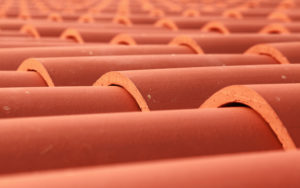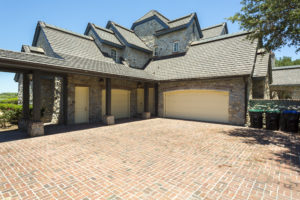
Are you looking for a roofing material that elevates the aesthetic of your home to unparalleled heights? Whether you choose clay, concrete, or slate tiles, tile roofs are synonymous with adding a romantic and exotic feel to your home. While most people are impressed by the look a tile roof adds to their home, there are several practical advantages to a tile roof as well. Beyond that, these advantages are backed by a lot of history.
In fact, many people don’t realize that tile roofs, actually date back to 700 BC in Greece. However, more recently, tile is backed by over a century’s worth of field performance testing in various parts of the world. Ready to learn more about the journey of tile roofing? We have the answers to your most common tile questions.

What is a tile?
According to Merriam-Webster, the definition of tile is a flat or curved piece of fired clay, stone, or concrete used especially for roofs, floors, or walls and often for ornamental work.Recently, tiles crafted from synthetic materials have grown in popularity as well. With tiles being made from a variety of materials, we will distinguish if a particular trait is related to a specific tile material or simply tile roofing in general.
Anatomy of tile roofing

To understand the anatomy of a tile roof, it is important to consider the different materials used in the construction of tile. While some tiles are made with slate, and others are made from synthetic materials, the two most popular options are concrete and clay. Although concrete and clay may seem similar, and they certainly share some commonalities, there are some important differences as well.
Construction
Clay tiles: Molded clay is baked into tile to produce clay tiles. Glazing and surface textures may be also be applied.
Concrete tiles: Constructed of sand, water, and Portland cement in different proportions. The tiles are molded under high pressure and heat. The tile may be finished with a paint-like material.

Weight
Clay tiles: Most clay roofing tiles weigh approximately 600-650 pounds per square.
Concrete tiles: Concrete tiles weigh up to 1,100 pounds per square.
Although concrete tiles are heftier than clay, using either material warrants consulting a structural engineer if you are interested in upgrading your roof to tile. It’s important to remember that not all roof structures support the installation of tile roofing (if your home doesn’t have it already).
Water & Weather
Clay tiles: Clay tiles typically have a water absorption of approximately 6%. In colder weather climates, clay tiles have been known to crack because of freezing (and subsequent thawing). This is one of the primary reason clay tiles are typically used in warmer climates. More so, clay is resistant to corrosion caused by salt air, so it is particularly popular on the ocean’s coastline.
Concrete tiles: Concrete tiles absorb at a rate of approximately 13%. This puts them at a higher risk of mildew and stains. The added weight will also add increased strain on your roof structure. However, concrete is not as susceptible to the cold weather and offers more versatility for a variety of climates.
While these materials have several notable differences, it is important to consider their similarities as well. For example, both clay and tile are non-combustible materials. Thus, they are resistant to fire. More so, both materials are resistant to hail and strong winds as well. Tiles are considered safe when installed correctly.

The look and feel of tile
When people think of tile roofing, they usually think of the popular terra-cotta clay tiles that are associated with Spanish and Southwestern style architecture. While concrete and clay tiles are more popular in natural earth tones, with a classic curved shape, and an unglazed finish, that is certainly not all tile roofs have to offer. Tile roofing actually comes in a variety of colors, shapes, and sizes. They are available in glazed and unglazed finishes. Both materials can be textured or smooth, and the edges of the tile can be uniform or have a ragged appearance.
30 years, 50 years, or more- How long will tiles last?

As we mentioned in our shingle post, the lifespan of a shingle roof varies based on a multitude of factors- including climate, weather, environment, maintenance schedule, and even the pitch of your roof. With that being said, manufacturer warranties for shingles can vary from 10 to 50 years (depending on manufacturer and product design).
In comparison, concrete have an average lifespan that lasts between 30 to 50 years, while clay may last well over 100 years. More so, slate tile has a typical lifespan of 100 to 150 years- or even longer. With that being said, from a longevity perspective, tile roofs are in fact better than shingle. Depending on climate and weather conditions, and how long you plan to own your home, you may not need to do a roof replacement after installing a tile roof. However, while you may not need to replace your entire tile roof, there may come a time where you need to replace the occasional tile.
Tile- What will it cost you?
A roof that can last 50 to 100 years sounds like a great choice, right? While there are a lot of pros to a tile roof, one con may be the price. Between the two options we’ve discussed, clay tiles can cost between 30- 50% more than concrete tiles- with clay tiles having an average price of $700 to $1,000 per square.
Common tile questions: In conclusion…
We’ve explored clay versus concrete in detail- from weight to weather, to design and longevity. As you can see, there are several advantages to a tile roof and many people would confidently say that tile roofs are, in fact, a good choice. Ultimately, the decisions come down to a couple of factors:
- Does your roof already have tile installed?
- If not, have you consulted a structural engineer to see if your home is able to support the weight of tile?
- If you are building a home for the first time, you are in a great position to build a home that can accommodate tile.
- Selecting clay, concrete, slate, or synthetic tile can be tough. Consult a roofing professional who can advise the ideal tile for the climate in your area, as well as your desired aesthetic.
Regardless of your particular situation, Roof Commander is happy to answer any questions you may have about choosing tile for your roof. Consulting a local contractor is always the best option when deciding on a new roof.